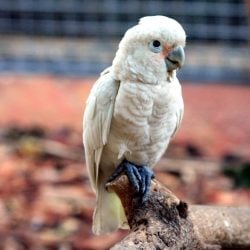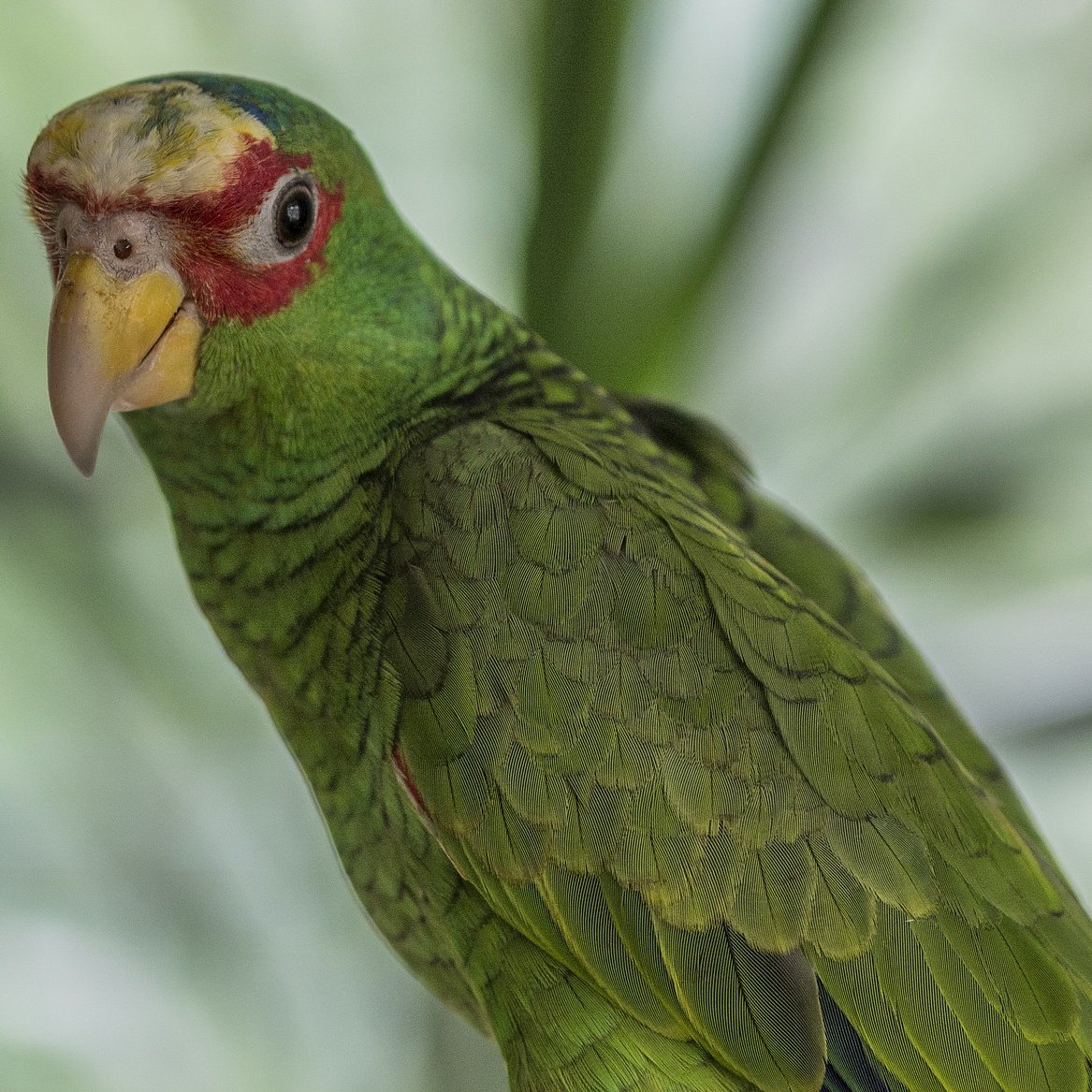Last Updated on by Mitch Rezman
On Sun, Oct 16, 2016 at 12:54 PM UTC, Joyce wrote:
Hello,
We live in southern TX, and would like to take our Amazon outside since the weather is so nice this time of year. I will purchase a cage of course, but my concerns are what types of bugs and disease am I potentially going to expose her to? She will also be in a covered patio. How do I keep her safe?
Thank You,
Joyce
Hi Joyce,
Thanks for your questions and your sincere concern for your Amazon’s safety. I have had companion parrots for 30+ years and for 7 years had an outdoor breeder aviary. I currently happily share my life with a single Timneh African Grey, Timmy, who is a rescue from a bad home but tame and loving even after what he has been through (including being batted against a wall, losing consciousness).
I do clip wings slightly to prevent upward flight, unlike Mitch and Catherine. But that is a personal choice and I love to hear of flighted birds. So I am not truly an advocate of clipping, it’s just best in my situation.
I live on the east coast of Central Florida, just south of Kennedy Space Center and only 4 blocks from the ocean. This area is sub-tropical, just as your weather is right now in Texas. We also have summers much like yours (hot, hot, hot and often dry), though you probably have colder winters than we do.
The only concerns you should have about your bird outdoors as long as it is safely caged or in a harness or flight suit is it consuming standing water or any grasses that could have been sprayed with pesticides and the ambient temperature. Cool strong breezes can cause respiratory infections or “colds”.
Overheating can kill quickly if not recognized and controlled. Consuming or chewing on items that may not be bird safe such as metals, pressure treated wood, and similar items could cause poisoning that could kill the bird.
While we humans are plagued by concerns such as West Nile Virus, Zika Virus, Malaria and other maladies due to insect bites from mosquitoes and are plagued by other stinging insects, my research and personal experience have revealed no diseases transmitted to parrots via bug bites. Consider this: our parrots evolved to live in pest-infested jungles with insects we’ve never encountered, yet they remain healthy.
On good weather days, my Timmy and I go outside in the unfiltered sunlight for at least 20 minutes to help both our bodies produce needed Vitamin D naturally. It also helps us absorb the vitamins we consume in food.
While I get bug bites if I do not protect against it, Timmy never is bothered. Perhaps it is the way parrot feathers create a tight, thick layer of protection between the environment and their skin so that biting pests can’t penetrate the feathers.
The only pest I am aware of that you should worry about is mites. The only way your Amazon would get these is if you allowed him to play extensively in outdoor trees where these pests live.
Wild birds live with them but you don’t want to bring them inside your house as they do cause itching in birds. This is why you should wash and bake at low temperature for 20-30 minutes any branches brought indoors for perches. This ensures any mites present are killed.
When outdoors, use the temperature rule that if you are hot and perspiring, the bird is also getting too hot, and if you feel chilly, so does your bird. Also, during hot weather, if the bird opens its beak as if panting, go into a cool area or spray water on the bird because that is a sign of overheating which can kill quickly. Parrots have no sweat glands to control body temperature.
When you are outdoors, you experience pests, so I’d like to refer you to a blog post about bird-safe insect repellents, Mitch and Catherine use these and so do I, they are all natural and keep pests away from you and the parrot.
Visit 6 Bird Safe All Natural Home Made Mosquito Repellants……. I know you will find it useful. You can make a batch and use it for the rest of the season. It has been bird-tested with Mitch and Catherine’s birds and mine. The repellents really do work well and are safe with the single exception that you might have an allergy to an ingredient.
To test for that, drop one drop of the oil on a cotton ball and quickly touch it to your skin. If no reaction appears (redness, itching, burning, discomfort of any kind) then you are not allergic to the ingredients. Most people are not allergic to any of the ingredients but there are rare exceptions.
If you read the ingredients and the essential oil is made from a plant or flower you know you are allergic to, then you are allergic to the essential oil. If that is the case, choose one of the mixtures that do not contain that specific ingredient or simply leave it out of the mixture.
Do allow them to dry before permitting your bird to enter the area and, of course, do not spray directly on the bird. They have residual effects for up to one week if the area remains dry, although outdoors it might be less, especially if rain gets the area wet. But they dry quickly so it is not a long wait to spray again around the outdoor cage after dampness or rain.
If you have further questions or concerns, please contact me.
Written by the Windy city Parrot content team
Your Zygodactyl Footnote
Author Profile

Latest entries
 Bird & Parrot CareJune 20, 2025Understanding the Best Way to Use Prevue Pets Mimic Me Voice Trainer
Bird & Parrot CareJune 20, 2025Understanding the Best Way to Use Prevue Pets Mimic Me Voice Trainer Bird BehaviorJune 6, 2025How Do I Keep My Parrot From Dumping His Food Every Day?
Bird BehaviorJune 6, 2025How Do I Keep My Parrot From Dumping His Food Every Day? Birds & LightingMay 16, 2025I Am Seeking Clarity About Lighting for My Birds Cage
Birds & LightingMay 16, 2025I Am Seeking Clarity About Lighting for My Birds Cage Bird RescueApril 29, 2025How Do We Re-Home a 17 yr Goffin Cockatoo?
Bird RescueApril 29, 2025How Do We Re-Home a 17 yr Goffin Cockatoo?





Lola Montez
30 Oct 2016I take my parrot outside in nice weather, but never without supervision. We take his ENTIRE CAGE outside, so there is no risky transfer to an outside screened area. I am less worried about the weather (parrots evolved OUT OF DOORS, folks!) than predators. I know several stories of pet birds, very tame, taken out of doors without a cage and they were taken by hawks! That is your real risk. Not mites or insects or even a nice breeze.
Obviously it has to be quite warm outside to do this — high 70s at least — and no high winds. A cage can be TOPPLED by a strong wind and pop open! We use a LOCK on the door for that reason.
I can tell you our parrot ADORES this, and is very excited by the fresh air, light breezes, and “bird noises” all around him. It’s a nice break from his normal inside habitat. Because he never leaves the cage, I feel he is perfectly safe. We put him on a picnic table, which is under an umbrella. You must take care not to leave a bird in strong sunshine (as noted in the article) because if he is confined, he cannot retreat to shade as a wild parrot would!
I even take my caged parakeets outdoors on lovely days!
WindyCityParrot
30 Oct 2016Yes we believe in exposing our birds to the outdoors we feel it’s very fulfilling to all of their senses Lola
Lisa
30 Oct 2016Great info, thank you! Like Lola, I know of a ‘predator’ instance, where a raccoon or something similar nipped off the toe of a parrot in an outdoor cage. You intend to supervise anyway, so just stick with that! Have fun! I wish I could do this for my two Amazons, but their cage is not small and portable like yours. Years ago when I did it, it was immediately apparent that the top of the cage felt like exposure to them, they were looking upward constantly… so I’d cover that, or your porch roof will help.
WindyCityParrot
30 Oct 2016There’s always that chance Lisa so basically lesser birds arcades inside we can never leave them fully unattended
Catherine Tobsing
4 Nov 2016Outdoor Tip from Mary Jo Harrison
I live in South Central Texas. I moved from a colder climate. I asked my vet about placing my African Grey outside during nice weather. He said to do a candle test in cage location and at times of day. Put candle in holder, leave and go back in 30 min. If candle is out or wax is splattered unevenly then the area has a draft. He advised making sure that area is positioned to only get indirect sunlight. This to prevent over heating. The last was to have no bird feeders or attractions in immediate area.